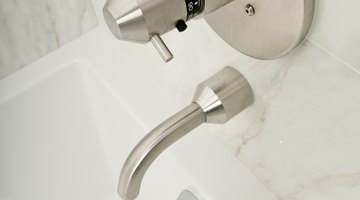No Hot Water From a Tub Faucet Diverter
Shower valves that supplies both a showerhead and a tub spout require some type of diverter. When functioning properly, a diverter allows the user to direct the water in whichever direction she likes -- to the showerhead or to the tub spout.

If the diverter is not working properly, however, it may block all or a portion of the water from reaching one of its destinations.
What Diverters Do
Diverters can be used in many types of showers, including tub-and-shower combinations. A diverter does not affect the rate of the flow of water or the water's temperature. Instead, it works by blocking off one avenue of the water's flow, which forces it in a different direction. A diverter may be located on the tub spout, on the shower valve itself, or as a separate valve and handle. Because water is mixed in the valve before it reaches the tub spout or a separate valve, only a malfunctioning diverter that is part of the shower valve may have an adverse affect on water temperature.
Troubleshooting
If you notice a difference in water temperature between the showerhead and the tub spout, the problem likely is related to the diverter. Diverters close off pipes by physically blocking them. If you have hard water or sediment present in the water, it may build up on top of the diverter over time, causing one of two problems. The diverter may no longer close properly, so water is no longer moved from one source to another, or the diverter may block more than it was intended to. If the buildup is enlarging the portion of the diverter that blocks the pipe, it also may block the flow of hot water to the valve.
Cleaning
Clean your valve and diverter to remove some types of buildup and blockage, which may help free the hot water to its source. Shut off the water to your bathroom and open up the diverter and the shower valve to the middle positions. Use a screwdriver to remove the handles and face hardware. Soak the handles and all moving parts of the diverter in undiluted white vinegar to help free up and remove any buildup. Examine the interior of the valve; if it appears to have buildup or sediment, soak cloths in vinegar and apply them to the valve to clean it. Replace the handles and faceplate, turn on the water and test the diverter.
Replace It
Diverters make up only a small portion of your shower valve. If the diverter has ceased to function properly, and cleaning it has not helped, consider replacing the spindle portion of the diverter within the valve. Remove the handle and the faceplate from the valve and look at the bottom of the valve where the diverter is located. Undo the retaining nut with a hex key, and locate and pull off the nut and the washer. Thread a screw into the center of the spindle and pull to remove the diverter. Replace it with a new spindle, washer and nut, and replace the faceplate and handle.
References
Writer Bio
Sarabeth Asaff has worked in and has written about the home improvement industry since 1995. She has written numerous articles on art, interior design and home improvements, specializing in kitchen and bathroom design. A member in good standing with the National Kitchen and Bath Association, Asaff has working knowledge of all areas of home design.
Photo Credits
- Jupiterimages/Photos.com/Getty Images
- Jupiterimages/Photos.com/Getty Images
More Articles



